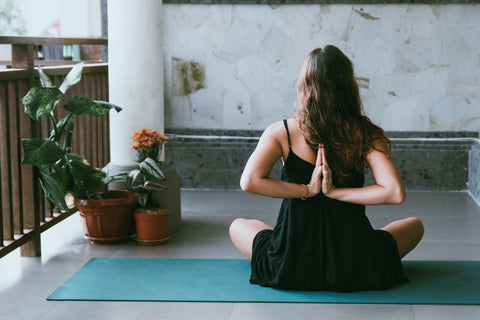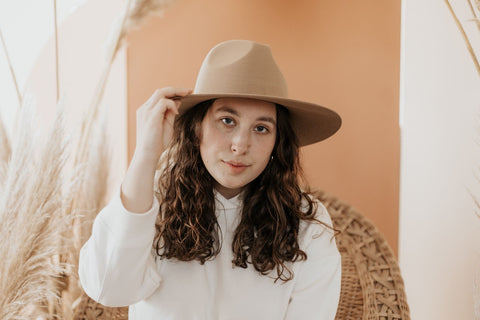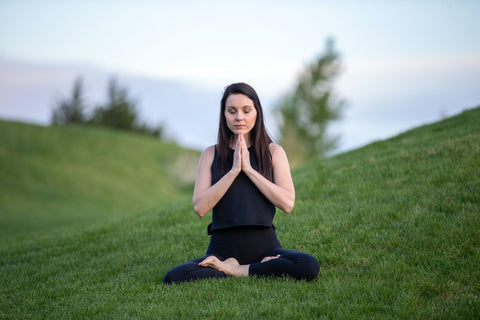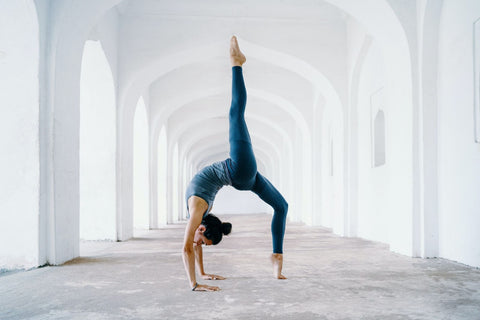You enter the yoga studio for the first time, and you’re ready for a fun, challenging experience. You roll out your mat, take some deep breaths, but things get a little rocky when the instructor starts throwing out cryptic terms and expressions you’ve never heard in your life!
Yoga is meant to be relaxing, right? What’s with all these weird words, and what the heck do they mean? Just like any other hobby or practice, you’re going to need to get up to speed if you want to make the most of the yoga lifestyle, and we’re here to help.
Here are some of the most confusing yoga terms explained with crystal clarity so you can get a head start and maximize the enjoyment and effectiveness of your practice.
Why Sanskrit?
Before we jump into the tongue-twisting terms used in the yoga studio, let’s talk about the language on which the foundations of yoga are built: Sanskrit.
Sanskrit is technically a “dead” language, meaning nobody uses it conversationally from day to day. However, it lives on in yoga, with instructors and practitioners using it in studios and classrooms to honor the 5,000-year tradition.
That’s right, the earliest accounts of yoga are found in ancient Sanskrit texts such as the Upanishads and the Bhagavad Gita – both of which contain amazing stories and philosophies that scholars still study in the 21st century.
Don’t worry; you don’t need to go back to college to learn the ins and outs of the Sanskrit language, but it helps to know the most common terms used in modern practice. That’s what we’re here to do today.
Types of Yoga

The first yoga terms you’ll encounter will be found on class listings and studio websites before you ever roll out the mat. There are countless types of yoga practiced all over the world, each with different focuses on breathing, movement, meditation, and more.
As you browse through the offerings at your local studio or gym, the most common term you’ll see is Hatha yoga, which is an umbrella term for all the poses and postures in the yogic practice.
While other types of yoga are more focused on service and meditation, Hatha is popular because it’s so applicable and easily followed in a group session. If you’re brand new to the world of yoga, look for a beginner Hatha yoga class to get started on the right foot!
The next type of yoga to consider is Vinyasa, which is a step up in athleticism and challenge. You will be expected to follow some more intense flow-oriented routines and have a decent level of balance and strength.
Vinyasa is all about coordinating your breath and sticking to the sequences laid out by the instructor. Be ready to put in some work and burn some calories in these sessions!
Once you really start leveling up your skills and abilities, you should check out Ashtanga yoga, which follows a very strict and demanding sequence of poses.
When you’re really feeling up for a challenge, sign up for a Bikram or Hot yoga class where they crank up the heat and humidity for a super intense experience. Every instructor has their own practice, but you can expect to sweat buckets during this challenging routine.
Finally, you may find Restorative yoga classes offered at your gym if you just want an easy way to wind down after a long day or an exhausting workout. Yoga isn’t always about pushing yourself, so enjoy some relaxed stretches and chill out with this style of class.
Types of Poses

Once you’ve selected your class and slipped into your favorite stylish yoga outfit, it’s time to get into the action! You’ll want to keep your mind, ears, and eyes open so you don’t miss a thing.
After you position your mat and sit at the ready, the instructor may throw out some unique terms to get everyone on the same page with breath and intention.
As the class ramps up, your instructor may use the term Asana to describe postures or poses. These poses each have their own names that symbolize animals, religious figures, Hindu gods, or everyday items.
Listen for words like Utkatasana (chair pose), Savasana (corpse pose), or Tadasana (mountain pose) and be familiar with the common patterns. Even the seemingly “easy” poses are meant to be challenging in their own ways, and instructors will keep you on your toes.
To make things easier on yourself, learn that pattern recognition is key to a successful yoga practice. You will see similar sequences everywhere you go, so make a mental note to follow the flows.
Nearly every yoga class you attend will guide you through a series of repeated Sun Salutations, which will push your body and mind to the limit. You will start by extending your arms upward to “greet” the sun, then step back onto your mat in a sequence that stretches your legs, glutes, hips, and arms. These get way easier with time, so stick with it!
This is where you’ll likely first hear terms like Downward-Facing Dog and Chaturanga. The best way to learn these poses is by imitating the motions of your instructor or following charts and videos from books or online. Practice makes perfect, and you’ll improve quickly if you make it a daily thing.
As your practice gets more serious, you’ll be challenged with poses like Warrior, Pigeon, Eagle, and more. Once again, the only way to improve at these postures is to put in the work and not be afraid to fail (even if it means falling on your butt now and then)!
Over time, you’ll see how various poses flow and connect to one another, and you will be more in touch with your balance and breath to make the experience more effortless and enjoyable.
Also, be ready to hear different phrases and terms to describe familiar sequences and poses. There are some common threads in yoga, but everyone has their own style. The more time you spend on the mat, in-studio, or at home, the more flexible you will be in body and mind!
Expressions and Ideas

Some yoga terms are more conceptual and don’t refer to a particular pose or stretch.
For example, most classes begin with a moment of calm and controlled breathing, which instructors might refer to as Pranayama. This is meant to get you in the zone and focused on inhaling and exhaling at a steady, relaxed pace.
This isn’t just about following the pack and timing your breath for perfection – it’s a moment of peace and quiet before you get into the more intense portion of the session.
Another term to study is Bandha, which translates to a tightening or tensing of the muscles to strengthen the link between your mind and body. You may be instructed to flex or squeeze your neck, abdomen, pelvic floor, or other areas of the body to engage and energize your system.
You might also hear talk of Chakras which refer to energy centers along the spine from the base of the pelvis to the top of the head. This is a fascinating topic worth exploring, and you might learn something about yourself in the process!
At the beginning or end of the class, an instructor may review a Mantra that you repeat aloud or keep in mind throughout the session. This term simply means “repetition” and is meant to keep your focus on spiritually positive or powerful ideas.
Of course, there’s no better way to end yoga class than with a long Om (meant to synchronize group consciousness) and Namaste (a signal of gratitude to everyone present). These terms will get you far in your yoga practice, but there’s always more to learn!
Gear and Accessories
Whether you’re brand new to yoga or a seasoned guru, you probably know the importance of having the right tools of the trade.
A great yoga mat is essential for comfort and grip during the toughest sequences, and yoga blocks and straps will help you get a few extra inches of stretch to really push yourself on a mental and physical level.
Finally, you’ll want to invest in some quality athletic wear to complete your look and maximize performance. A sleek outfit will help you look and feel great while going through the motions. You don’t want any baggy t-shirts or sweatpants to hold you back!
While you’re busy studying Sanskrit texts and practicing your poses, let the professional stylists at Yoga Club handle your outfits so that you never run out of fashionable fits.
Our process is so simple – just a quick and easy quiz to learn about your shape and style is all we need. Just sit back and enjoy a new outfit every month! With your outfits on point, you can focus fully on mastering the art of yoga, one pose at a time.
Sources:
15 Words To Know So You're Not So Confused In Yoga Class | Yoga Practice
10 Common Yoga Terms to Know Before Your First Class | aaptiv.com






